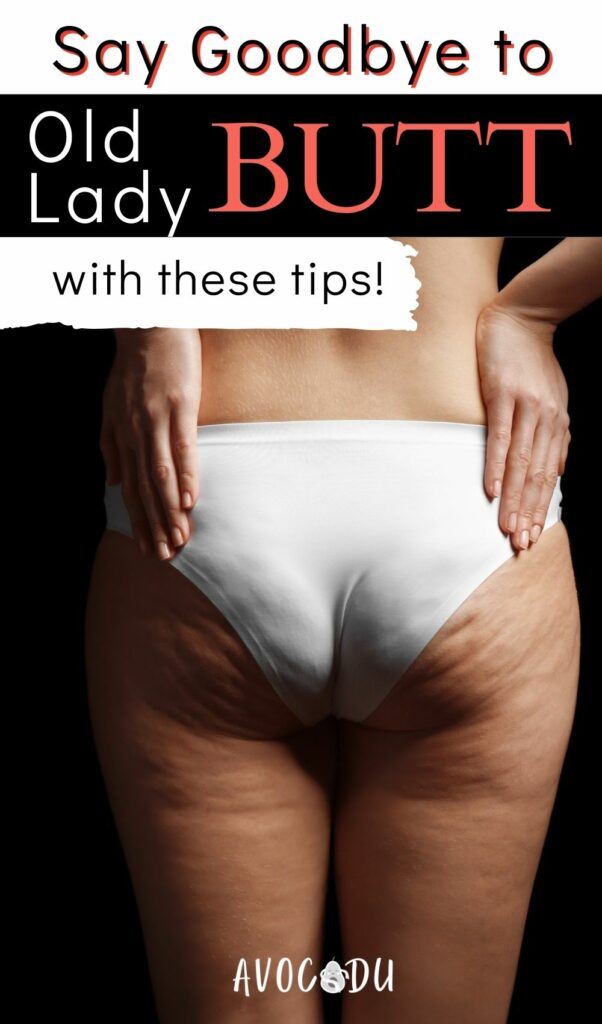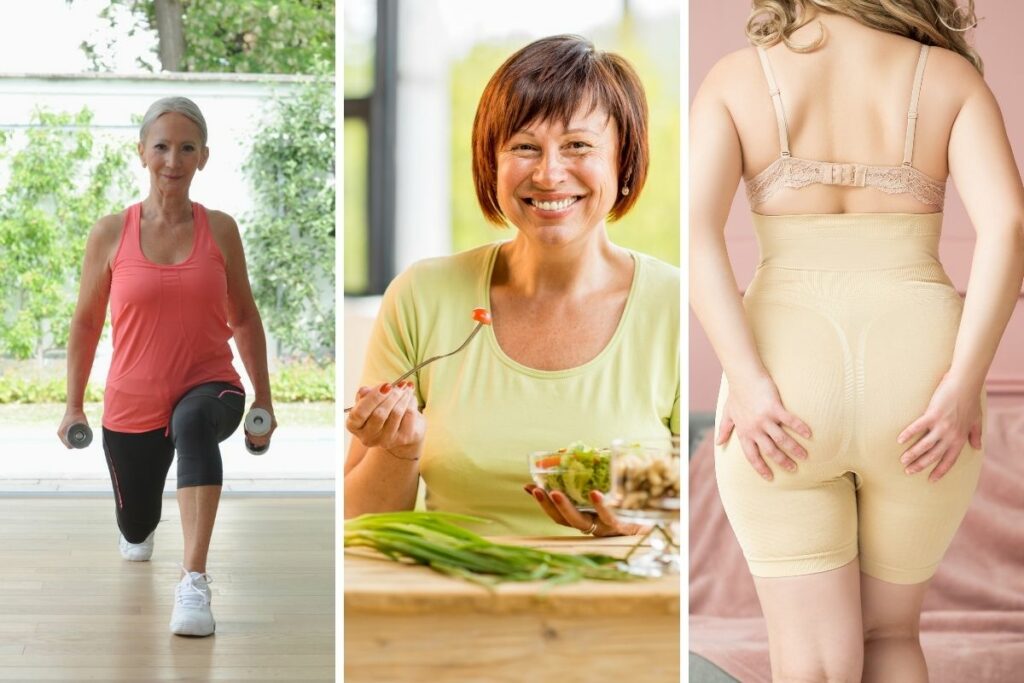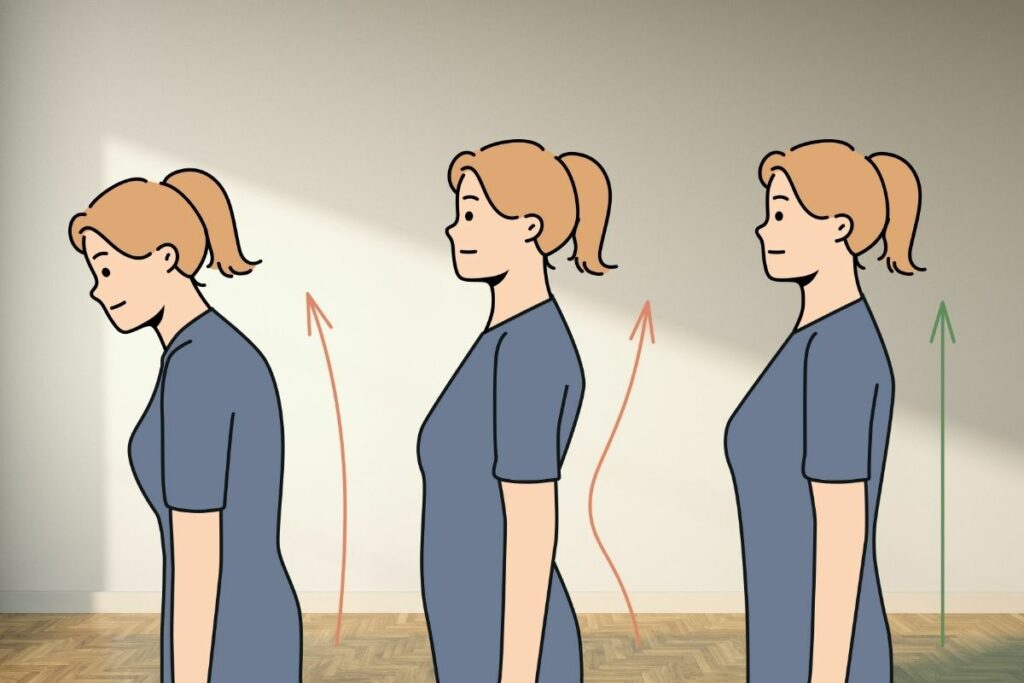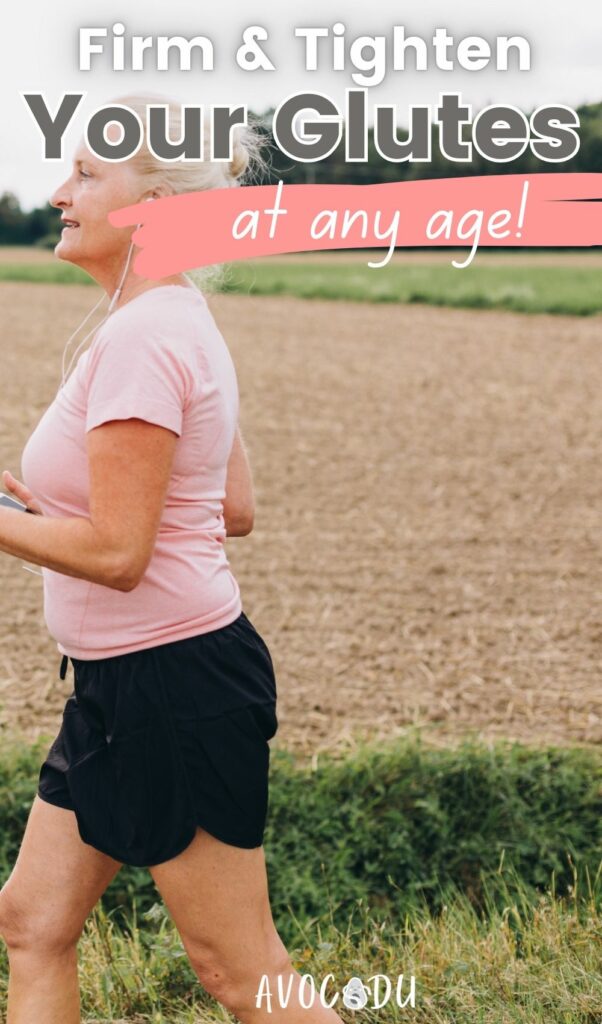How to Prevent “Old Lady Butt”
Nobody wants to think about their backside losing shape, but it’s something many people worry about as they age.
I’m sure you’ve heard (and maybe even used) the term “old lady butt,” when your rear end becomes saggy or droopy. Most women hate the idea of it and feel self-conscious when they notice their backside starting to lose its shape.
It’s a common concern, especially as the body changes with age, and of course, no one likes the thought of losing their once firm, lifted booty.
Here’s the best part: while you might not be able to stop these changes entirely, there are plenty of options to consider that can help reduce them.
With the right exercises, posture tweaks, and smart nutrition choices, you can keep your backside looking more lifted and firm.
There are also temporary solutions, like creams and shapewear, or even more permanent options, like surgery, if that’s something you’re interested in exploring.

Related article: 10 Best Butt Workouts You Can Do at Home (No Equipment Needed)
This post may contain affiliate links, which helps keep this content free. Please read our disclosure for more info.
What is “Old Lady Butt” and Why Does it Happen?
As you age, your body naturally loses muscle mass, especially in areas like your glutes, which can make your backside look flatter or less defined.
This loss of muscle can happen faster if you’re less active than you used to be, as your muscles need regular movement and exercise to stay toned.
Collagen production also decreases with age, which means your skin starts to lose its firmness and elasticity. Collagen is what helps keep your skin tight, so when your body makes less of it, the skin around your glutes can start to sag.
On top of that, fat distribution in the body changes over time, and you may lose fat in your rear, further contributing to the flattening effect.
Sitting for long periods or poor posture only adds to the problem. When you sit too much, your glutes aren’t engaged, which weakens them. Over time, this lack of activation causes them to lose their shape.
Without the right movement and exercises, the combination of muscle loss, decreased collagen, and changes in fat distribution can lead to that “old lady butt” look.
Related article: 6 Butt Exercises for an Instant Booty Pump
How to Improve “Old Lady Butt”: What Works and What Doesn’t

While you may not be able to completely restore your glutes to how they looked when you were younger, there are plenty of ways to improve their shape and firmness.
Some strategies work better than others, and it’s important to know what’s worth your time (and money) and what’s not.
What Works:
- Strength Training and Glute Exercises (Inexpensive & Effective): Building muscle is your best bet to improve and start reversing “old lady butt.” Exercises like squats, lunges, hip thrusts, and deadlifts are all fantastic ways to firm and shape your glutes. These can be done at home with little or no equipment, or at the gym with weights for added intensity. Resistance bands are a great low-cost addition to increase the challenge of these moves.
- Diet and Nutrition (Inexpensive & Effective): Eating a balanced diet with enough protein is crucial for muscle maintenance and growth. Focusing on whole foods like lean meats, fish, eggs, and plant-based proteins will give your glutes the fuel they need. Healthy fats and hydration also play a role in keeping your muscles and skin healthy.
- Posture and Movement (Inexpensive & Effective): Small changes like standing tall, engaging your glutes while walking, or getting up from sitting every hour can make a big difference over time. These don’t cost anything but require awareness and consistency.
What Doesn’t Work:
- Prolonged Sitting (Inexpensive & Harmful): Sitting for extended periods weakens your glutes and can worsen sagging. This is a habit to avoid, and regular movement is key to keeping those muscles activated.
- “Quick Fix” Creams or Lotions (Moderately Expensive & Ineffective): While firming creams and lotions might temporarily improve skin texture, they won’t address the underlying muscle atrophy that causes “old lady butt.” These products might make your skin feel tighter, but they won’t help with sagging or glute strength in the long run.
Expensive Options:
- Surgical Solutions (Very Expensive & Risky): Procedures like Brazilian butt lifts or glute implants can be an option if you’re seeking dramatic and immediate results, but they come with a high price tag and significant health risks. Surgery doesn’t address long-term muscle maintenance, so it’s not a substitute for proper fitness habits.
- Shapewear and Butt Pads (Moderately Expensive & Temporary): While shapewear or padded underwear can give you the appearance of a fuller, lifted butt, these are only temporary solutions. They do nothing to strengthen or firm your muscles and can sometimes even mask the issue.
If you focus on muscle-strengthening exercises, consistent movement, and healthy nutrition, you’ll see the best long-term results—without breaking the bank!
Related article: How to Get Rid of Cellulite on Thighs and Butt
Exercises to Strengthen and Shape Your Glutes

The most effective way to improve the look of your backside and prevent “old lady butt” is to focus on strengthening your glutes.
By consistently targeting these muscles with the right exercises, you can build muscle, enhance your shape, and improve firmness. Here are some of the best exercises to incorporate into your routine:
- Squats: A classic for a reason, squats work your entire lower body, including your glutes, quads, and hamstrings. They’re great for building muscle and toning your backside. You can start with bodyweight squats, but for an added challenge, hold a dumbbell or kettlebell. There are also many variations to keep things fresh, like sumo squats or pulse squats, which help target different areas of the glutes.
- Lunges: Whether you’re doing walking lunges, reverse lunges, or even side lunges, this movement engages your glutes while also improving balance and strength. Lunges help build stability and can really help shape the sides and overall contour of your glutes. To increase difficulty, hold weights or add a slight pause at the bottom of each lunge to really activate the muscles.
- Hip Thrusts/Glute Bridges: These are some of the most effective exercises for isolating and strengthening your glutes. Hip thrusts or glute bridges are designed to maximize glute activation. Start by doing them with just your bodyweight, and as you get stronger, place a weight (like a barbell or dumbbell) across your hips for added resistance. The key is to engage your glutes at the top of each movement for the best results.
- Deadlifts: Romanian and sumo deadlifts are powerhouse moves for building not just your glutes, but also your hamstrings and lower back. This compound movement is great for developing the entire posterior chain, which helps improve overall muscle balance and posture. As you progress, you can gradually increase the weight to continue challenging your muscles.
- Step-Ups: Step-ups are fantastic for toning your glutes while also improving your coordination and balance. Use a sturdy step, box, or bench, and focus on pushing through your heel to engage the glutes. To increase intensity, hold weights or use a higher step, which will put even more focus on the glutes and legs.
- Resistance Band Exercises: Adding a resistance band to exercises like clamshells, lateral walks, or kickbacks can take your glute workout to the next level. Resistance bands are great for isolating the glutes and adding extra tension, making these smaller movements more effective. They’re also perfect for home workouts or warm-ups before weight training.
These exercises should be done consistently to see the best results. Aim to work on your glutes at least three times a week, allowing time for recovery between sessions.
As you get stronger, gradually increase the intensity by adding weights, resistance, or more challenging variations.
Over time, you’ll notice an improvement in the shape, strength, and firmness of your glutes.
Posture and Movement Adjustments

Maintaining proper posture and staying mindful of how you move throughout the day can significantly impact the tone and shape of your glutes.
While exercises play a major role in strengthening your backside, your everyday habits can either help or hinder your progress. Here’s how small adjustments to your posture and daily movement can keep your glutes more engaged and prevent sagging.
- Standing Posture: Proper standing posture is essential for keeping your glutes activated, even when you’re not working out. Avoid slouching or letting your pelvis tuck under, which can weaken the glute muscles over time. Instead, stand tall with your shoulders back and your spine in a neutral position. Engage your core and focus on slightly squeezing your glutes as you stand. This not only helps maintain good posture but also keeps your glutes working even when you’re just standing around.
- Sitting Posture: Many of us spend long hours sitting, whether at work or home, and this can lead to weakened glutes over time. When sitting, make sure to sit with your feet flat on the ground, your spine straight, and your pelvis neutral. Avoid slumping forward or rounding your back, as this puts pressure on the lower back and takes the engagement away from your glutes. While sitting, you can even do small glute squeezes or shift your weight slightly to activate your muscles and prevent them from becoming dormant.
- Move Frequently: If you sit for long periods, it’s crucial to get up and move every hour or so. Sitting for too long not only weakens the glutes but also shortens the hip flexors, which can further inhibit glute activation. Set a timer if needed to remind yourself to stand, stretch, or take a short walk. Even small movements can help get your blood flowing and keep your glutes engaged.
- Walking with Purpose: How you walk can also make a difference. Instead of mindlessly shuffling from place to place, think about using your glutes as you walk. Push through your heels and consciously squeeze your glutes with each step. This can help activate and strengthen your glutes throughout the day, turning an ordinary activity into a mini workout for your backside.
- Squeeze the Glutes: Incorporating small glute squeezes into your day is an easy way to keep your muscles engaged. Whether you’re standing in line, walking up stairs, or even getting out of a chair, squeeze your glutes as you move. These small but consistent movements help activate your glutes and contribute to better muscle tone over time.
- Climbing Stairs: If you have access to stairs, use them! Stair climbing is an excellent way to engage your glutes during daily activities. Push through your heels as you climb, making sure to focus on engaging your glutes rather than relying solely on your thighs. This simple adjustment can help tone your backside while also improving overall leg strength.
By being mindful of how you stand, sit, walk, and move throughout the day, you can keep your glutes active and help maintain their tone and shape. These small adjustments, when combined with regular glute-targeted exercises, can make a big difference over time.
The Role of Diet and Nutrition

Your diet plays a huge role in maintaining muscle tone and preventing glute sagging as you age. If you want to keep your backside firm, focusing on proper nutrition is key.
The right foods support muscle growth, skin elasticity, and overall body composition. Here’s what to focus on:
- Protein: Protein is essential for building and maintaining muscle, especially as you age. Make sure you’re getting enough from sources like lean meats, fish, eggs, beans, and lentils. Protein helps muscles recover after workouts and prevents muscle loss that leads to sagging.
- Healthy Fats: Healthy fats from avocados, nuts, seeds, and olive oil help maintain your body’s fat distribution and skin elasticity. These fats support hormone balance and help keep your skin soft, which is important for reducing sagging.
- Hydration: Staying hydrated is key for skin elasticity and muscle function. Aim to drink plenty of water throughout the day, especially if you’re working out. Hydration keeps your skin firm and helps your muscles work properly.
- Supplements: Consider adding supplements like collagen to support skin elasticity and creatine to help maintain muscle mass. These can give your glutes an extra boost as you age.
By focusing on these key aspects of your diet, you can support your body’s ability to keep your glutes strong and firm, helping to reduce the appearance of sagging over time.
Keeping Your Glutes Strong and Shapely
Losing muscle tone in your glutes might seem like a natural part of aging, but it doesn’t have to be. With consistent exercise, mindful posture, and a balanced diet, you can keep your backside firm and lifted for years to come.
The key is building the right habits and sticking with them. Whether it’s incorporating glute-focused workouts, making simple adjustments to how you move, or fueling your body with the right nutrients, every step makes a difference.
If you’re ready to take things a step further and kickstart a more comprehensive approach to fitness and fat loss, check out our 21-Day Fat Loss Challenge.

This program is designed to help you shed body fat while building lean muscle, giving you the tools you need to transform your body—including your glutes!
With a clear plan, guidance, and support, you’ll be well on your way to a stronger, shapelier backside. Start today, and say goodbye to “old lady butt” for good!

